Text
Discovering Boston’s Innovation + Entrepreneurship Ecosystem with MBA students from Fribourg
By Gilles Suard, Junior Project Manager
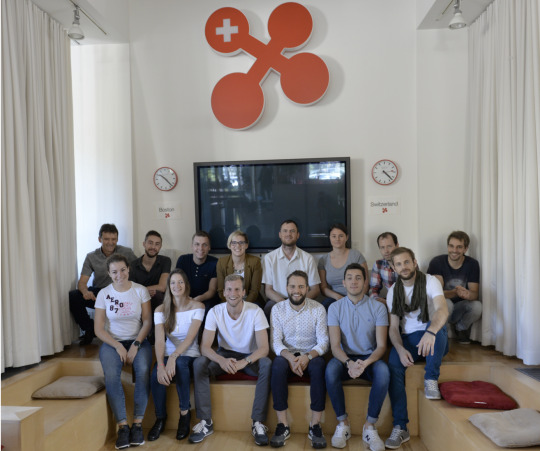
In October 2017, swissnex Boston welcomed 13 students from the School of Management Fribourg, accompanied by the School’s Director, Professor Rico Baldegger. The HEG Fribourg (HES-SO) offers a Master of Science in Business Administration with a major in Entrepreneurship, Innovation and Growth Management.
Every year, as part of this program, the scholars have the chance to fly over the Atlantic to discover new markets and explore the Entrepreneurship ecosystem of Boston. This year, the students are working closely with Swiss companies to tackle the challenges that arise when entering new markets -- and adjusting their innovation strategies accordingly. swissnex custom-built this 5-day program to complement the students’ needs and interests.
DAY 1
The intense discovery started with a presentation from McDermott Will & Emery on the legal aspects of doing business in the US. Following visits to Autodesk and NVBOTS, the students had the chance to learn more about 3D printing in startup incubators and co-working spaces and from a fast-growing startup. A great lunch was offered by Legal Sea Foods with a presentation of their entrepreneurial journey. The afternoon started with a presentation of swissnex by Jonas Brunschwig and Gilles Suard. Then, Hampus Hillerstrom presented his life science company, Proclara Biosciences, and his current organization LuMind, a Down Syndrome research foundation. The day ended with an energetic presentation from Maram Al, founder of Viemate, a real estate startup.

DAY 2
It began with an interesting lecture from Jos Scheffelaar, the founder of “Launch In US” Alliance, a consulting company helping European companies entering the US market. Afterward, the renowned Bill Aulet introduced the Center for MIT Entrepreneurship and talked about his book, 24 Steps of Disciplined Entrepreneurship. In the afternoon was an exclusive visit of Draper Lab at its brand new Kendall Square location. Students learned more about the high-level engineering company and its Sembler program, which empowers startups through engineering. To end the day, the group traveled across the city to participate in a startup showcase, including a talk on the future of Digital Health, hosted by Boston Children’s Hospital Digital Health Accelerator and Pulse@MassChallenge.
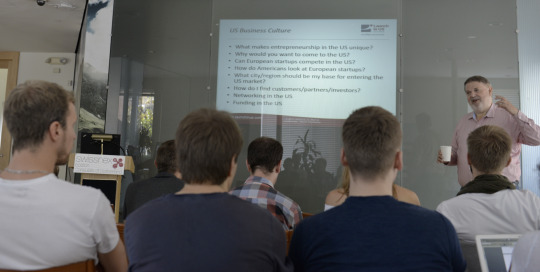
DAY 3
The MBA students attended an event at Harvard Business School on Engineering + Entrepreneurship innovation in Healthcare. The highlight was a real HBS case study, presented by an expert from HBS. It was followed by a startup showcase, along with an inspiring discussion on the power of ‘storytelling in entrepreneurship’ at Harvard i-lab, which incubates and accelerates entrepreneurial projects from Harvard students.

DAY 4
This day was focused on corporate innovation, with a visit to Johnson & Johnson Innovation Center, hosted by Anders Linden. The students learned about the involvement of J&J within the Boston ecosystem, with a focus on creating strong networks and collaborations with external parties as part of their Open Innovation strategy. In addition, J&J organized a workshop on venture financing for entrepreneurs, academics and industry experts in their JLABS facilities, which welcome startups and provide valuable mentorship with a ‘no strings attached’ approach. Just across the street from JLABS, the students enjoyed a campus tour of Massachusetts Institute of Technology, given by Jonas Brunschwig, Project Leader in Academic Relations at swissnex Boston, who is also currently a student at MIT. In the afternoon, a presentation of the Cambridge Innovation Center provided an overview of co-working spaces and their role in this ecosystem. Then, Professor Lou Shipley from MIT Sloan kindly invited the group for a lecture in Entrepreneurial Sales. At the end this intense day, the students were still motivated to attend an event focused on the Clinton Global Initiative organized by swissnex Boston.

DAY 5
The MBA students spent their last day at Northeastern University where Gregory Collier gave an interesting lecture on Business and Revenue Model Innovation as well as a presentation on the efficient ventures accelerator, IDEA. After lunch on campus, Bill Hartman from Essential Design led the group in a Design Thinking workshop, challenging them to tackle the challenges they face in new ways. Startup accelerator MassChallenge was the finale of the study tour. Roman Kern, Senior Director of Global Operations and Technology took the group for an inspirational journey around the wide-ranging facilities, which are designed to help high-impact startups succeed.
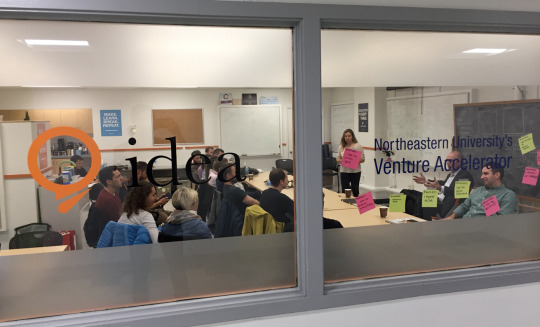

The students were positively overwhelmed by the impressive Innovation and Entrepreneurship dynamics in Boston. The knowledge acquired throughout this week of visits, presentations, discussions, and learning will help them as they embark on their second year of their MBA.
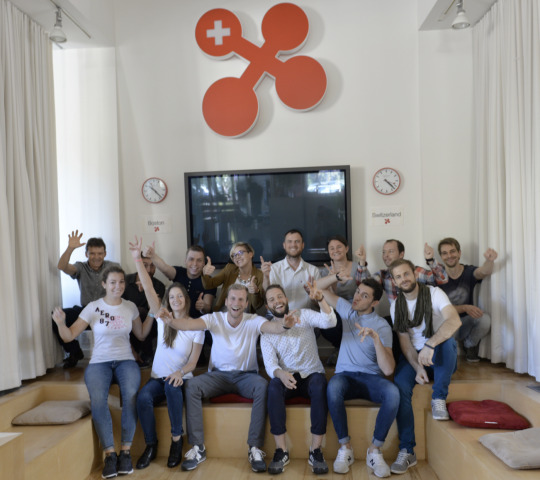
1 note
·
View note
Text
Panel discussion about Open Innovation
By Alexander Zuend, Junior Project Manager

swissnex Boston recently hosted a panel discussion on the topic of Open Innovation and Boston’s innovation ecosystem. The panel was comprised of:
Maren Cattonar, Co-Founder of Automated-Analytics (moderator)
Bram Goorden, General Manager at Prometheus Therapeutics
Anders Linden, Transactions at Johnson & Johnson Innovation
Daniele Foresti, Research Associate at the Lewis Lab at Harvard
Gilles Suard, Jr. Project Manager at swissnex Boston

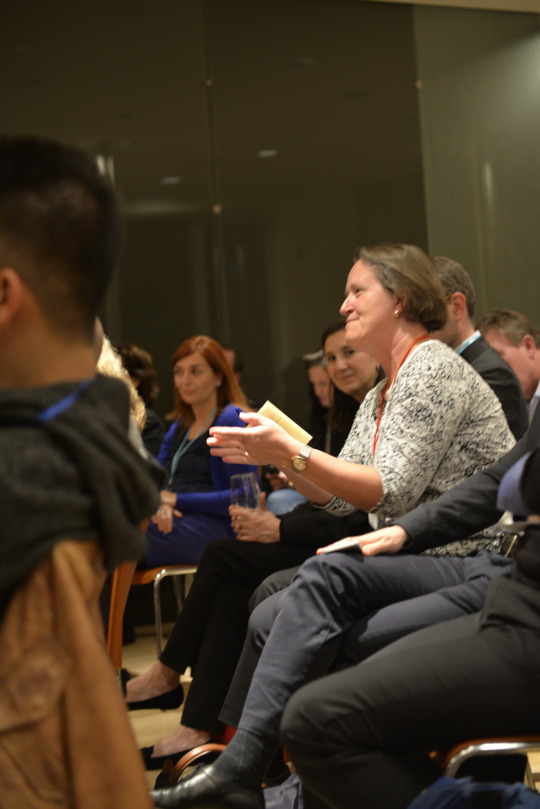

All panelists were convinced of the high importance of open innovation, but their opinions diverged when it came to the question of how it is best achieved.
The approaches differ strongly from company to company, mainly concerning the desired relationship with the “small fish,” i.e. startups. Some companies act as the “big fish," supporting the small ones around them in the perspective of a future cooperation, whereas others are more like sharks, simply acquiring the startups with technologies they want to have. Often times this means a lot of change for the newly acquired startup: founders and staff may leave the company and with them goes the drive for further innovation.
On the other side, the unconditional support of startups holds high risk for the big fish as well, because at one point a startup could very well just turn its back and go its own way. And anyway, what exactly should companies be offering the startups that it’s helping?
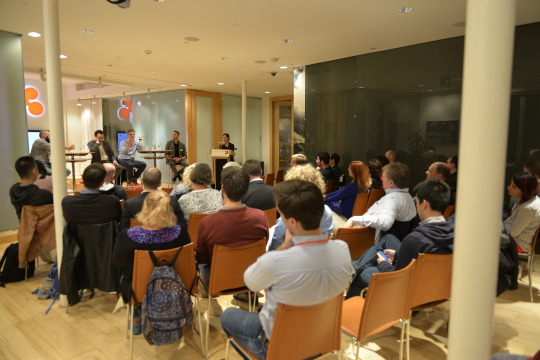
The opinions about open innovation differed greatly, but in one point everybody agreed: Boston’s ecosystem holds enormous potential, and lets young entrepreneurs meet the right people.
After the panel discussion was networking. The crowd consisted mostly of researchers and students from local as well as Swiss universities. Also, representatives from startups, large companies, consultant firms and accelerators were present.
2 notes
·
View notes
Text
Technology showcase in Boston with CSEM
By Lola Saugy, Junior Project Manager
A few weeks into the new academic year marked the right moment for swissnex Boston’s first innovation event of the season. Organized in partnership with the CSEM, the theme was Swiss-made technologies and their reliability.

The CSEM, Centre Suisse d’Electronique et Microtechnique, or Swisss Center for Electronics and Microtechnology, is one of the world’s top innovation centers. This research institute has many fields of expertise, ranging from microsystems to nanosurface engineering, printed electronics & sensors to medical technologies - and also vision technologies and photovoltaics & energy management.
Many industries can rely on CSEM technologies: aeronautics and transportation, biotechnology, IT, energy, watchmaking, healthcare, and also the semiconductor industries.
CSEM’s mission is to develop and transfer microtechnologies to the industrial sector, in order to reinforce its competitive advantage. The CSEM cooperates with established companies and creates startups.

Lola Saugy, Junior Project Manager, kicked off the evening with a brief introduction to swissnex Boston and its mission.
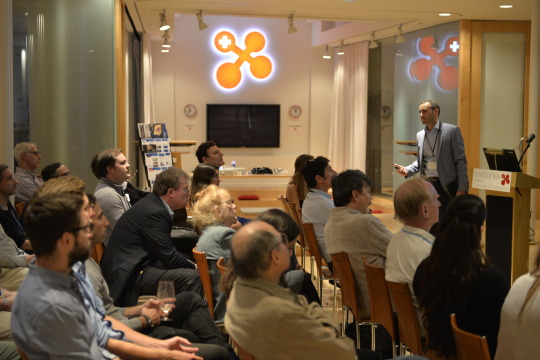
Then Bahaa Roustom, Business Development Manager, and Michele Palmieri, VP and Division head of Micro & Nano systems, gave a presentation of the CSEM. This evening was dedicated to MEMS (microelectromechanical systems), medical technologies, and photovoltaics.

Many interesting projects were detailed, such as the AVA wristband that tracks ovulation to double chances of conception - or building-integrated photovoltaics that are available in different colors to hide themselves.
Following these passionate stories, Vincent Linder, from OPKO Diagnostics, described the Point-of-Care devices for the In-vitro market, and mentioned that parts of these are made of Swiss technologies.
Finally, Brittany McDonough and Hallie Moran, Director of Global Partnershps and Operations respectively at MassChallenge, highlighted the Swiss market of startups. Indeed, there are 13 Swiss MassChallenge alumni between 2012 and 2015, including Biowatch SA, that works closely with the CSEM.
The networking buffet was full of interesting conversation between engineers, academic researchers, and business people.
We would like to thank the CSEM, our speakers, and everyone that came and made this evening memorable. Looking forward to see you at our next edition!

0 notes
Text
Back to School 2017: Fun (and Rain) in the Park!
By Francesco Bortoluzzi, Project Coordinator for Academic Relations
With the start of a new academic year in Boston comes time for our annual Back to School event, where local Swiss and Swiss-linked students and researchers come together to connect while playing some lighthearted yard games.

Following on the fun and nimble stride of last year’s event, themed around the Olympics, this year’s edition was also held on the Cambridge Public Library’s lawn, across the street from swissnex Boston.
More than 80 Swiss-linked people or friends of Switzerland (a record attendance!) competed against each other for the honor of taking home Emmi cheese, and gift cards to Switzerland and swissbäkers, a local, family-owned Swiss bakery. Thank you very much to these sponsors for providing these prizes!
This year the game participants were divided into eight teams of roughly ten people: two EPFL Alumni teams (with twenty alumni and current students, EPFL was again the most represented Swiss university), ETH Alumni, Friends of Basel & Switzerland, HSG Alumni, Great Geneva Area, SNSF & Researchers, and UZH Alumni & Friends.

Alas, however, the fun in the park was short lived. In a sudden and unexpected turn of events, rain and thunder barreled in, just as the games were in the thick of the action, requiring a quick (and quite athletic!) break down of the games, followe by shelter-seeking inside swissnex.

Safe from the torrential rain, in the cozy event space of swissnex Boston, the more than 100 competitors and other guests engaged in swissnex’s favorite discipline: networking, with the help of a tasty reception and drinks.
The swissnex team whipped up a raffle for the sponsored prizes after briefly introducing themselves.
Most importantly, attendees connected with past contacts from before summer, others made new ones in a land far from home.
New arrivals to Boston could also learn about the many Swiss alumni and social chapters in the area, thanks to a series of posters detailing activities and contact information for each organization. The evening ended on a high note despite the weather-related interruption.
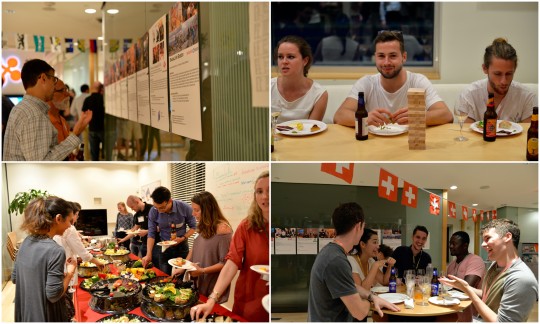
The swissnex team would like to thank sponsors Emmi Switzerland and swissbäkers, Boston’s Swiss alumni and social chapters, and all of the guests that joined us to celebrate yet another exciting start of the academic year.
0 notes
Text
Going Global
By Francesco Bortoluzzi, Project Coordinator, Academic Relations
September 12, 2017, marked the date for yet another exciting MIT Go Global fair, where students convened on the lawn of Kresge Auditorium to learn about opportunities for studying and interning abroad. swissnex Boston had its place under the fair’s tent representing Switzerland’s university landscape.


Two Swiss Federal Institutes of Technology were highlighted, given that they are the natural peers to MIT: ETH Zurich and EPF Lausanne. Alumni and a former exchange student (currently studying at MIT) were on hand to answer questions. Other Swiss universities were also featured and promoted by swissnex Boston staff.
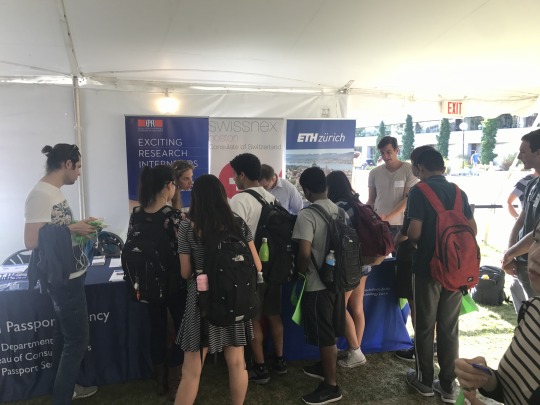
In this year’s edition, the students stopping by the Swiss booth were mainly undergraduates looking to integrate international experience into their curriculum, or are already planning ahead for their postgraduate studies. We hope to see them in Switzerland!
0 notes
Text
Mass Innovation Nights 💯 was out of this world 🚀
By Jennifer Lazea, Communications Staff

Mass Innovation Nights recently celebrated their 100th event sponsored Draper’s Sembler office and it was a hit. They had such roaring response that they had to close registrations early! The Museum of Science hosted the sold-out event and also allowed attendees to explore the museum before and after talks. They also amped it up with a Theater of Electricity Show but then the real space magic began.
Mass Innovation Nights was founded in 2009 by a group of people heavily affected by the economic downturn who wanted to launch an experiment. They wanted to leverage social media in order to create a community of local entrepreneurs and judging by the response – they were successful at their experiment.
The theme of the night was space technology and after a few words from the sponsors, representatives from eight startups took the stage to give a rapid-fire pitch on what they’ve been working on.
Analytical Space is solving the problem of sending large amounts of data from satellites in orbit back down to earth by using laser communication. They provide two services; satellite RF data relay which increases data throughput from existing satellites without changing hardware and IOT device connectivity which collects and delivers data from existing assets.
The Quantly Group – a company with an all-female core team focused on data collection took the stage next. This Harvard Innovation Lab Venture offers an analysis tool that yields very specific results to companies that want in-depth analysis.
Accion Systems has a different approach on generating ions for creating thrust by using technology that produce an electric field to accelerate ions. Their product TILE stands for Tiled Ionic Liquid Electrospray.
Valt Launch Systems is disrupting the way nanosatellites get into space by making a smaller more affordable launch vehicle. Their launch costs millions of dollars less than traditional launches.
Gaurdion Technologies, a MassChallenge finalist (congrats!) has developed a nanomaterials-based sensor to help Smart Cities be safer.
MoonWatcher gives you a “front row view of the moon.” Their images are unobstructed & real-time views of the lunar surface and will make you feel almost like you’re actually in space.
Upstream tech is changing the way freshwater resources are managed and measured using satellite imagery and machine learning. They aim to empower environmental conservation using their technology.
Lastly, we have Kernel. Kernel is a software platform from TellusLabs that delivers daily agricultural insights through a web application, API, and push notifications.
Overall #MIN100 was a success and we look forward to following the journeys of the startups involved. Mass Innovation Nights 101 sponsored by MIT Sloan Executive Education will be the next event in the series.
0 notes
Text
The MassChallenge 2017 Finalists drew a huge crowd and here is why
By Jennifer Lazea, Communications Staff
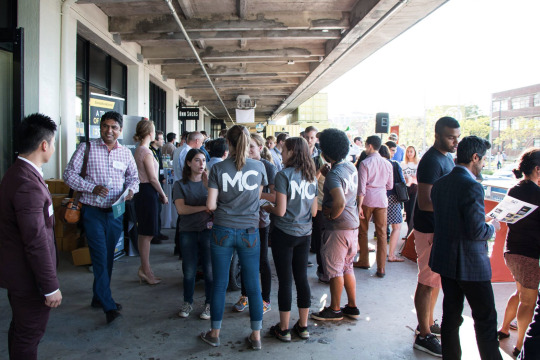
The line to get in to see the finalists at the MassChallenge Showcase stretched far - all the way to the end of the Innovation and Design Building on Dry Dock Ave. Startup aficionados and other entrepreneurs excitedly conversed in line about the companies they were most looking forward to meeting as they received brochures from MassChallenge staff. Once the crowd reached the gate there were several different directions to go in; the startups were divided into categories – Energy & Clean TechGeneral, Retail, & Consumer Goods, High Tech, Social Impact, and Healthcare & Life Sciences.
There were some familiar faces seen at the showcase including Life Sciences Global Pitch Fest participants Nonspec, a low-cost, durable, and hyper adjustable prosthetic device provided to developing nations as well as
Z-Imaging; an augmented reality system that helps surgeons operate safer and faster. There were also plenty of new pioneers in the mix as well.
A company that is doing something to save lives is Alleviant. Alleviant is an early stage medical device company focused on developing a novel transcatheter treatment for congestive heart failure. This company has created a device that creates a shunt between two atria by removing tissue from the interatrial septum, this allows for an instant decompression within the left atrium. According to founder, Dr. Jacob Kriegel, they are beating the competition by conducting their procedure stent-free. Having no stent means that there is less room for blood clots and other often-fatal mishaps.
The next startup helps solve a very large issue that you probably don’t think of an a day-to-day basis. They are trying to help people avoid taking fake medications. Veripad is a health IT company that has created an affordable option for identifying drug authenticity. In developing nations counterfeit drugs are often a problem but with Veripad technology all the person has to do is place the crushed medication onto a test paper and then use their phone application to take a photo of it in order for the drug to be identified.

Our next startup highlight is Versatope. This startup has an amazing technology that delivers immunity with nanometer-size versicles using a synthetic biology technology. Surprisingly enough, the nanovesicles are derived from the outer membrane of a genetically engineered and detoxified E. Coli strain. Since the vaccines are not cultured in allergens, they are a great alternative for people that suffer from allergies, but that’s not all they’re even useful for cancer immuno-therapies!
The next two companies mentioned are fresh off the boat from the Life Sciences Global Pitch Fest. Z-Imaging is a company born out of the Harvard Innovation Lab by a group of undergraduate, yes, undergraduate students at Harvard. They are using augmented reality to let surgeons see inside of their patients, making image-guided surgeries safer and faster.
The other veteran of the Pitch Fest is Nonspec, a start-up company determined to design, develop, and deliver, low-cost, durable prosthetics to developing nations. Our goal is to mass-produce easily customizable prosthetics that can fit any amputation site. They are surely changing the lives of many people in developing nations.
A consumer goods company that seems very promising called Sleepbox. Let’s get a show of hands - Who likes to take naps? Sleepbox is a solution for quick relaxation. They provide a comfortable and private space for employees to nap or work while in the office. About According to Sleepbox, 40% of people chronically under-sleep and businesses lose $411 billion due to a lack of sleep. Resting for just 40 minutes makes an individual 40% more productive during the day and increases awareness by 100%. If the statistics don’t convince you then maybe their sleek design will.

The MassChallenge finalists have proven that their products and technologies have the potential to disrupt entire industries. We can’t wait to follow them on their journeys and we also wish all of the Mass Challenge finalists the best of luck with their ventures!
(first image by MassChallenge)
0 notes
Text
Health and Sport - insights after the Race Across America
Gilles Suard, Junior Project Manager
On June 26th, swissnex Boston welcomed the Team Pulse from HESAV right after their outstanding performance at Race Across America, one of the longest and most respect ultra-endurance event in the world. It started in Oceanside California, from where international cyclists pushed their physical and mental limits all the way to Annapolis, Maryland. Eight ultra-motivated cyclists from HESAV’s Team Pulse took part of the experience to represent HESAV as well as Switzerland throughout this extreme Race.

The Swiss community, sport enthusiasts, Health and Exercises specialists, Public Health students and Bostonian’s cyclists had the opportunity to hear from the Team Pulse who shared their spectacular experiences lived throughout the race. Essentially, they endlessly ate delicious hearty food cooked with love by the chef on board, enjoyed the impressive landscape, exchanged a few laughs, and stayed determined all the way both under heavy rain and intense heat of 125°F (52°C). The interactive and fun Team debrief was followed by a presentation on the scientific experiments conducted before and during the race from Professor Kenny Guex of HESAV.
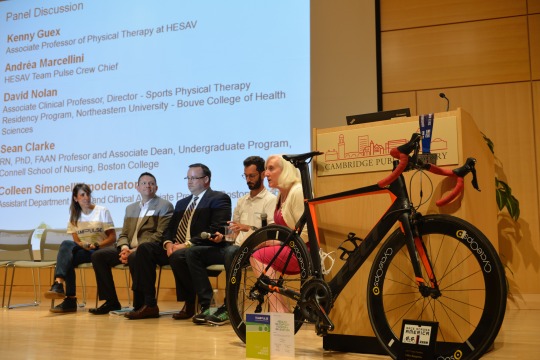
A panel discussion where experts from the fields of health, physical therapy and sports discussed the intersection of sports and health both in extreme situations such as the RAAM, as well as in normal everyday situations. David Nolan, Associate Clinical Professor, Director of Sports Physical Therapy Residency Program at Northeastern University - Bouve College of Health Sciences and Sean Clarke RN, PhD, FAAN Professor and Associate Dean, Undergraduate Program at Connell School of Nursing - Boston College, compared statistics in Switzerland and USA explaining that 72% of the Swiss population engages in moderate exercises, which is defined by 2 hours 30 minutes or more, whereas the number in USA is 20%. They ensured that the overall quality of health is improved by regular exercising, thus, it remains a challenge in USA to promote exercising as a result of positively influencing life expectancy and quality of life. When it comes to extreme endurance situation, it is crucial to set needs and expectations as well as prepare an accurate training program to build up foundations of body and bone strength, flexibility and cardiovascular fitness.

The event was followed by a networking reception at swissnex Boston, where the participants had the chance to continue the discussions and mingle with the Team Pulse.
0 notes
Text
Near-Death Experience: A conversation with Jelena Martinovic
By Dan Aufseesser, Junior Project Manager

Some of humanities oldest unresolved questions have been: what is death? And what happens after it? However, a topic less known is that of Near-death experiences (NDE). Described by certain people as sensations of well-being, out-of-body experiences, traveling through a dark tunnel, or an “Empyrean ascent”, representations related to near-death experiences have profoundly influenced collective conceptions of how we imagine the very last moments of existence.
Jelena Martinovic is a UNIL–CHUV Post-doctoral Research Fellow and just ended a Visiting Post-Doctoral Fellowship at Harvard University in the History of Science department. She came at swissnex Boston on Wednesday, June 7th to present her new book Mort Imminente, Genèse d'un phénomène scientifique et culturel with a talk titled “Near-Death Experience: How Psychiatry Leveraged a Folk Phenomenon into Therapeutic Insight”.

MORT IMMINENTE, Genèse d'un phénomène scientifique et culturel
Auteur(s):Jelena Martinovic ; Edition: MétisPresses ; Collection:
Fabrica; ISBN: 978-2-94-0563 14-2
This topic has been recorded since antiquity but Jelena focused her presentation on integration of NDE research in modern medicine and psychology since American psychiatrist Rusell Noyes studies in the 1950s. After her fascinating talk, Jelena was kind enough to answer some of our questions:
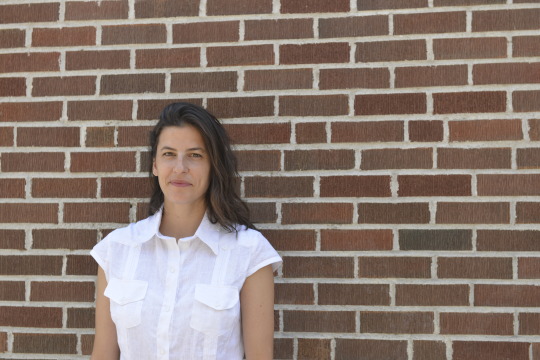
Dan Aufseesser (DA) What do you feel is today’s consensus on NDE in the medical world? How well is your research received by MDs?
Jelena Martinovic (JM): I would say the acknowledgment that an NDE has a meaningful impact on a person’s life – although the study of NDE remains contested. So far, my research has been mostly received by MD psychiatrists, who are interested in the neglected aspect of trauma studies, the correlations of spirituality and medicine, or a historical perspective on the “lessons” of dying. More generally, I think that my work relates to an audience of professionals working in the fields of medical humanities or palliative care/medicine.
(DA): What question concerning NDE do you think is most complicated to answer?
(JM): The most challenging (and probably impossible) questions to answer are why, and if, an NDE occurs. In other words, definition and epistemology are the central aspects. What are we talking about when we refer to NDE: is it a state in which a person believes they would die (during a mortal danger, or an accident for example) and reports this experience afterward, or a clinical situation in which a patient survives a heart attack or a coma? Can it even refer to a simulated state of near-death (out-of-body experience) in an experimental lab? It is extremely difficult to compare these different types of experiences and make a general argument out of that. Explanations have proliferated in many scientific and spiritual fields, especially since the 1970s, yet the somewhat more philosophical discussion about knowing, experiencing and negotiating the knowledge has been quite quiet. I hope that this history can add a tiny part to that remaining puzzle.
(DA): Do you think NDE can explain what death is? Or are they, paradoxically, completely different things?
(JM): Some say that NDE explains what death is because an NDEr (as the survivor is commonly called) returns from death. Yet, one must remember that the very definition of death varies historically, culturally and medically. Take for instance Western medicine’s definition of brain death (1968), which offered not only a legal framework that declared a body dead and yet its organs alive, but also multiplied representations (and fears) regarding the newly reconfigured frontiers of death and life. In other words, NDE does not explain what death is but rather, is about how we, culture and biomedicine, define (or not) death, pathology or health. Or, put more simply, it is about how we deal with transitional/inter-mediate states within a set of existing answers and speculation.
(DA): You said that most alpinists had similar NDE, does that show physiological reflexes or is it linked to a certain culture, vision of danger, death and life coming from this category of people. In other words, are NDE culturally influenced?
(JM): There have been several studies comparing NDE in different societies and emphasizing the impact of cultural representations of death and after-life. Regarding alpinism, I have been interested in a particular style of self-reporting near-death experiences in the 19th century and how that affected psychiatrists in their understanding of an "experience of dying". I am not sure what a history or ethnography of climbing survivors (and their potential self-reports) nowadays would look like.
(DA): What’s next in NDE research? Where do you see this field going?
(JM): I think it is moving towards virtual reality and psychopharmaceutical simulations of death. Recent studies have tried to induce the sensations of threatened death or existential angst (by micro-dosing with LSD and psilocybin, or designing emergency situations in VR laboratories). This development is in fact a reactivation of a series of endeavors from the 1960-70s, in which death was “mimicked” to investigate a fundamental question: how to reduce anxieties towards death? In other words, in recent years there seems to be a certain revival of humanist ideas about death and dying in laboratory work.
(DA): AI is the hot topic at the moment. Can it help us understand NDE?
(JM): You are anticipating my answer, thank you. AI is a hot topic of course, because it brings back into play fantasized analogies of, and blurred frontiers between, mind/machine, animal/human, and life/after-life. Another emerging field articulates sociobiology, with stress studies and experimental studies (VR or animal research) to understand affective behaviors in living organisms within a life-threatening danger situation. Again, this teaches us (at least the historian) less about death than about cognitive psychology’s definition of, and quest into, understanding risk behavior and altruism.
(DA): What is your next research going to be about?
(JM): I am still working on a draft for my next book. I have a continuing interest in altered states of mind and have recently begun work on a history of mescaline studies (the chemical compound of the psychoactive cactus peyote). At this early stage of research, I pay particular attention to how pharmacology relates to human sciences, and anthropology to experimental science.
Purchase and learn more about the book
here.
0 notes
Text
The 2017 Life Sciences Global Pitch Fest was a Sailing Success for Startups
By Jennifer Lazea, Communications Staff

Every year since the early 2000s and in partnership with Venture Lab, the Venture Leaders, a group of representatives from the most cutting-edge startups have made their way from Switzerland to the United States. As Boston has firmly established itself as a hub for life sciences it is only natural that the companies selected for the weeklong business-building event are in the fields of medtech and biotech.
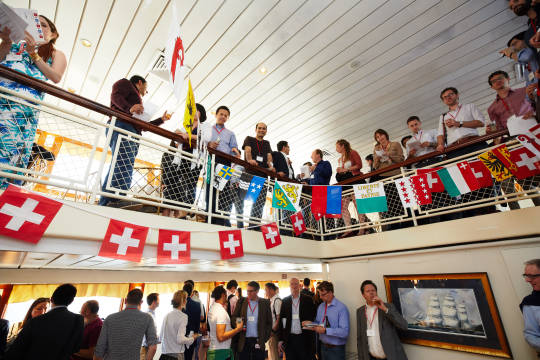
They come here to learn about the U.S. market, properly structuring their companies, and to attend workshops. There is also a large focus on perfecting their pitch. Entrepreneurs looking for funding and partnerships must be able to communicate what their company does in a very clear and concise manner in order to effectively convince busy investors. swissnex Boston Project Leader for Innovation and Entrepreneurship Philippe Labouchere and Junior Project Manager Charlotte Broennimann devised an action-packed schedule and accompanied the group throughout their intellectual adventure. The Venture Leaders attended company visits and workshops at Paraexel, Babson College, MassBio, Massachusetts Life Science Center, Ernst & Young, as well as Cambridge Innovation Center where they were given constructive feedback to strengthen their pitches.
Their first pitch to a crowd occurred on Monday, June 12 at the Swiss residence of Dr. Felix Moesner, Swiss Consul and CEO of swissnex Boston. Present were experts in the life sciences and startup fields as well as distinguished guests; including the State Secretary for Education, Research, and Education (SERI) Mauro Dell’Ambrogio and Ambassador Mauro Moruzzi. This event allowed the group to dip their toes into pitching to a large crowd before taking the plunge for the Life Sciences Global Pitch Fest on board The Majesty.
The Life Sciences Global Pitch Fest is swissnex Boston’s signature event of the summer where representatives from two of the most innovative places in the world go head to head in a competition to be the best pitcher. For the second year the event was held with the picturesque backdrop of the Boston Harbor, creating an intimate environment perfect for not only listening to the speakers but also for the networking to come afterwards.
The energy was at an all time high with entrepreneurs trying their best to stay within the lean format of the “1 minute, 1 slide” guideline. After one minute went by a quintessential Swiss cowbell rung to announce that the time had run out, a quick introduction from moderator and then it was time for the next pitcher to convince the jury and the audience that their product or technology was truly the best.

Audience votes were collected dutifully by swissnex Boston staff and meticulously counted, rendering Tiba Bioetch to be the winning contender. Tiba Biotech designs novel vaccines within seven days from antigen identification and manufactures their vaccine products at scale within an additional seven days with lower capital and operational costs. They received a Swiss gift basket as a prize.

Following the thought-provoking question, “what makes you a great CEO, “ the diverse jury, Sean Gallimore of Paraxel, Paul Pyzowski of Aleva Neurotherapeutics & Neurolectrics Barcelona, and Arjun Goyal of Vida Ventures, announced their pick for winner. Georges Muller of Dispencell, a solution to single cell experiments made possible by the use of a disposable and traceable single cell isolation system. The other Venture Leaders as well as the rest of the crowd cheered him on as he took the stage and received his prize, a certificate for a private coaching session with the esteemed Linda Plano of Plano and Simple to give him the opportunity to further fine-tune his pitch.
Attendees were invited to enjoy the rest of the evening networking with the sun setting over the Atlantic Ocean. We would like to take this opportunity to once again thank everyone who was involved in creating such a memorable event – we hope to see you in the future!
0 notes
Text
Pulse Finale: A digital health celebration for the future of digital health and the impact of ecosystem-wide collaboration
By Gilles Suard, Junior Project Manager
On June 13th, MassChallenge awarded $200,000 in zero equity prizes to three digital health startups from the PULSE @MassChallenge, which is the most startup-friendly digital health lab, connecting entrepreneurs to experts, institutions and resources. MassChallenge was launched as a strategic component of the Mass Digital Health initiative, a public-private partnership designed to accelerate the competitiveness of Massachusetts’s digital healthcare industry.

PULSE Finale gathered the digital health community at the Wilbur Theater to hear from MassChallenge executive team, leading healthcare organizations and policymakers. PULSE @MassChallenge jury selected 31 startups out of 430 applications from 30 states and 20 countries. They have spent the past six months working thoroughly with healthcare Champions to address some of the biggest issues patients face.
Participants had the opportunity to meet the entrepreneurs during the startup showcase before the celebration show presented by Nick Dougherty, Program Director, PULSE @MassChallenge. To begin, the premier behind-the-scenes documentary of the startups' journey was revealed. Then, Governor Charlie Baker, who was a keynote speaker at the event and shared his thoughts about the Digital Health Initiative and their investment to ensure that Massachusetts can continue to be a leader in advancing technological innovation, and provide better health care opportunities for patients around the globe. Dr. Jeffrey Leiden, M.D., Ph.D., Chairman, President and CEO of Vertex said "There is no better place for entrepreneurs to launch a digital health venture than in Massachusetts, where the world's top biotech’s research centers, universities, venture capital and startups are right next to each other."

Top startups were selected based on their ability to demonstrate impact and meet milestones previously agreed on with Champions. This year's first-ever winners of $100K is SyncThink, which is the first tool to objectively screen for ocular-motor synchronization, a key impairment in concussion. The 2nd Prize of $60K was earned by Twiage, an advanced cloud-based platform that uses best-in-class security technology to put telemedicine at the fingertips of emergency first responders and physicians to accelerate live-saving patient care. The $40K prize was granted to Rendever, which creates a research-driven virtual reality platform for elderly care to improve the quality of life of older adults.
In addition to the program winners, 3Derm, a teledermatology triage system that allows any user to take clinical-quality 2D & 3D images of concerning skin lesions and upload them for remote review by dermatologists, was awarded with the Sunovion Startup’s Choice Award. Finally, The MACP People’s Choice Award has been given to Act.md, which aims to help clinicians, patients, families, and communities address complex health and social needs all in one cloud-based platform. The closing after party allowed attendees to mingle with the digital health community and network with MassChallenge’s stakeholders.
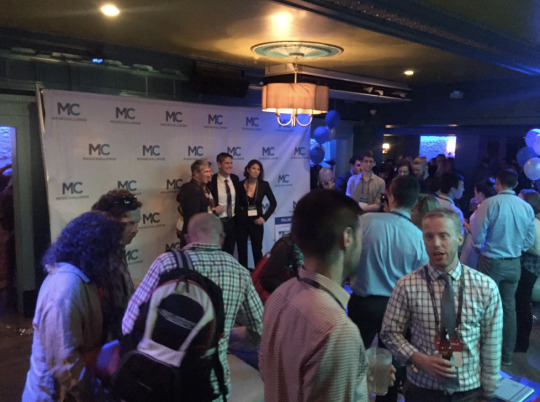
0 notes
Text
Global Healthcare Summer School at swissnex
By Gilles Suard, Junior Project Manager

On June 9th, swissnex had the pleasure to welcome nursing students from Boston College, HESAV, and LaSource both in Lausanne, Switzerland, and Pontifical Catholic University of Chile.
The Global Healthcare Summer School is an academic partnership between Connell School of Nursing (CSON), Pontifical Catholic University of Chile and two Swiss universities: Haute école de santé Vaud (HESAV) and LaSource. The universities offer a four-week global health course with topics that range from the commonalities and differences in health care systems and policies to public health, especially among the vulnerable populations. The overall objective of the course is to have the students engage with each other around healthcare issues to evaluate current practices in each country and discuss possible improvements.
This year, the students had the chance to engage in interactive lectures given by Dr. Terri Zucchero, Director of Nursing, Research and Education at Boston Health Care for the Homeless Program (BHCHP) and Elizabeth Donger, Research Associate at Harvard FXB Center for Health & Human Rights.
Dr. Terri Zucchero shared many aspects on the inspiring mission of BHCHP. As the largest American healthcare program for the homeless, they provide highest quality health care for all homeless men, women and children in the greater Boston. Amongst their services, homeless individuals can get help managing chronic diseases and access shelters. BHCHP acts as an alternative to the emergency room as well as a safe discharge location for medically vulnerable patients.
Elizabeth Donger spoke about her research focus on defining and addressing vulnerability in children with a focus on community-level strategies for the prevention of harm to Children in India. Moreover, she gave the student further insights about her actual projects, which aim to assess the health and wellbeing of urban adolescent refugees in Ecuador and Zambia.
The nursing students contributed to the discussion by sharing their thoughts in relation with the services and projects applied in their own countries. Finishing their first week in Boston, all of the students were excited about the upcoming program full of visits, lectures, and discoveries of alternative Healthcare practices in Massachusetts.
0 notes
Text
MALSI 2017
By Gilles Suard, Junior Project Manager
The 10th Massachusetts Life Sciences Innovation (MALSI) Day was a big day for Life Sciences Startups and the innovation in the Commonwealth of Massachusetts. This year the Massachusetts Technology Transfer Center (MTTC) successfully brought together scientific leaders and business experts to mingle with scientists, post-docs, professors, entrepreneurs, innovators, and venture capitalists. Major organizations, which are involved in supporting the Life Sciences Startup ecosystem within the state, contributed to the flagship event.
This year, MALSI took place at the prestigious Harvard Club of Boston where the enthusiastic participants had the chance to be part of panel discussions, discover the Innovators’ Marketplace, enjoy a networking reception with leading industry CEOs, and enter the poster competition.

The program allowed the attendees to take a journey into the world of entrepreneurship including discussions with Founders and CEOs of recently founded Startups who talked about their first steps and issues encountered in terms of funding, validation of concepts and life adjustments. A panel discussion was animated by inspiring entrepreneurs who shared their entrepreneurial voyages following their previous participation as MALSI inventors. Key insights of the talk provided tips to entrepreneurs such as the importance of identifying the right VC or Angels and the pivotal aspects of the elevator pitch to face funding challenges. More importantly, panelists highlighted the relevance of the passion involved in resolving a problem as well as being result-oriented to bring all the resources down the road with commitment.
In the midst of networking breaks and startups showcases, highly active individuals in open innovation from L’Oréal, J&J Innovation center, Eli Lilly and Philips HeathTech Ventures discussed their collaborations strategies with Startups and academic institutions. As a result, these strategic alliances are beneficial for their own innovation performance as well as for startups development and research advances. Indeed, the “no strings attached” approach by J&J helps early stage Startups by welcoming them in their JLABS located in Cambridge. Another style by L’Oréal is the patent analysis approach to find new disruptive innovation in their field as a result of establishing collaborations. Moreover, startups can benefit from ventures funds of these companies. Panelists provided valuable insights to guide entrepreneurs and innovators when it comes to approaching big ventures.
The closing reception displayed an innovator marketplace allowing attendees to network, discover new companies as well as incumbent firms and assist to the MALSI 2017 poster award. This year’s winners are Mark Cartwright from the Wyss Institute ($2500 Charles River Innovation Award), followed by Daniel Dadon from Elektrofi and Ashok Chander form Cellanyx.
0 notes
Text
BU Art Administrations Masters students Visit swissnex Boston
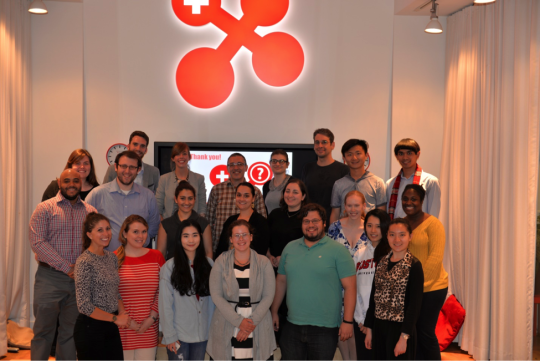
By Dan Aufseesser, Junior Project Manager
It is well known that diplomacy is an art, but how diplomacy deals with art is less known.
On May 31, a group of Boston University students enrolled in the Art Administration Master program came to visit us at swissnex Boston. Led by their teacher, Mr. Lanfranco Aceti, this class in Comparative Cultural Policy was here to inquire about Switzerland’s cultural policy and swissnex’s role in this framework.
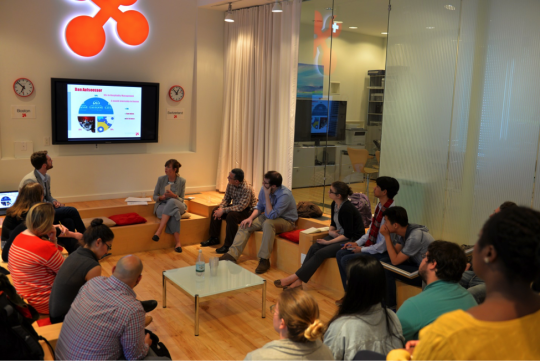
More than 20 students gathered in the pit to listen to the presentation our Art/Science team had prepared. As it is so often the case in Boston, our guests came from all around the world, so it was essential this meeting started with a brief introduction into Switzerland’s artistic landscape. After giving few key facts and figures about Swiss literature, music, architecture, design, fashion, photography, film, visual arts and museums we offered our guest a glimpse of Switzerland’s Cultural Policy.
We first introduced the Swiss federal system to our visiting students. This allowed us to explain the roles the OFC (Federal Office for Culture) and Pro-Helvetia (Swiss Arts Council) have on a Federal level, the roles of the cantons (states) and highlight how important Swiss cities’ engagement is. A few comparisons with the US allowed students to put in perspective Switzerland strong public involvement in the promotion and creation of the arts and the importance of public-private partnerships.

Image, (L to R): Yearly Budget of: the OFC, the US National Endowments for the Arts and Pro Helvetia.
Before explaining how they came to work in Boston, Cécile and Dan shared more about the specific role swissnex plays in Switzerland’s cultural policies. They presented past and future projects to showcase how art/science diplomacy can be done.
Finally the floor was given to the students who had some very interesting questions. They showed great curiosity in learning more about the different funding opportunities that exist in Switzerland, the apprenticeship system, the way art students are regarded in the Swiss society and how they integrate the art and job markets.
A networking reception followed which was the occasion for students to deepen their curiosity and to meet each other as this was their second day of class. It was a pleasure to host this class and we hope that the perspective we gave them will allow them, along with their trips in London and Dublin, to have a broad understanding of different Cultural Policies.
0 notes
Text
UZH Presidential Delegation and “UZH Night” at swissnex Boston
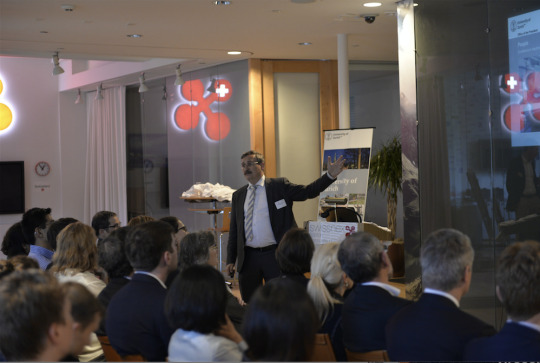
By Nicolas Solenthaler, Junior Project Manager
On May 25 and 26, the University of Zurich’s President Michael Hengartner accompanied by the Executive Board, deans, and professors gave a visit to the Boston region. The University of Zurich is the largest university in Switzerland, offering the widest range of degree programs in the country, and one of the leading research universities in Europe. The delegation’s aim was to foster existing connections and to create new cooperations. Split into the two tracks “Medicine, Entrepreneurship & Innovation” and “Digital Society & Law”, the university representatives visited eleven different institutions in Boston’s thriving higher education and innovation ecosystem.
The first group on “Medicine, Entrepreneurship & Innovation” wanted to get inspired by Bostonian institutions’ promotion of innovation and entrepreneurship in the medical field and visited already partnering organizations such as the Wyss Institute at Harvard University and the Martin Trust Center for MIT Entrepreneurship, but also new ones as the Bob Langer Lab and the Harvard Stem Cell Institute, for instance. The University of Zurich is one of the most innovative European higher education institutions, as its 9th rank in the 2017 Reuters’ “Europe's Most Innovative Universities” ranking shows.

The other group on “Digital Society & Law” most importantly strived for inputs for the newly launched UZH Digital Society Initiative which deals with the digitalization of society and the sciences. The visits also aimed at elaborating potential new collaborations in this field. This goal brought the representatives to the Berkman Klein Center for Internet and Society, the Ash Center for Democratic Governance and Innovation at Harvard University, and the Network Science Institute at Northeastern University. Both groups were accompanied by members of the UZH International Relations Office, which organized the visit, as well as swissnex Boston staff, who supported the organization.
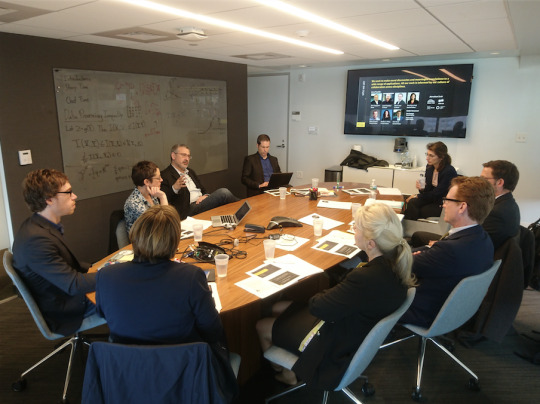
On the occasion of the presidential delegation’s visit, swissnex Boston and UZH Alumni and Friends Boston hosted the “UZH Night” on Thursday evening. Although Harvard University’s commencement took place the very same day, a wide audience of about 80 people came together. First, President Michael Hengartner gave a keynote on the University of Zurich’s strategy and internationalization. Vice President Christoph Hock then talked about innovation and entrepreneurial efforts at the university, and at last Professor Abraham Bernstein gave insight into the recently launched UZH Digital Society Initiative, of which he is part of the Board of Directors. Finally, the additional delegation members introduced themselves and their work in short pitches. The evening concluded in a very lively and long lasting networking reception with Swiss alumni, SNSF fellows, local universities’ affiliates and other stakeholders.
0 notes
Text
Meet some new faces at swissnex Boston!

Our team is growing and we would like to introduce you to Philippe Labouchère, Lola Saugy, and Gilles Suard. You can get to know these innovative fresh faces below!
Holding a PhD in solar energy from EPFL, Philippe is the new Project Leader in Innovation and Entrepreneurship at swissnex Boston. Before that, he graduated from ETH Zurich as a theoretical physicist and spent half a year as an intern at the science and technology office of the Embassy of Switzerland in Tokyo, Japan. He is more than ever ready to connect the dots to move forward with science, technology, innovation and lab-to-market entrepreneurial projects.

Lola is finishing her master’s degree in Applied Mathematics at the EPFL. She is absolutely excited to build relationships and to represent the CSEM (Centre Suisse d’Electronique et Microtechnique) here in the Greater Boston area. At the end of her 6 months at swissnex Boston as a junior project manager, she will do a master thesis; which will also hopefully be in the United States, which would last for 4 more months. Since this is her first time on the east coast she wishes to explore as much as possible and of course see some whales.

Gilles is a new junior project manager at swissnex Boston. He is currently finishing up his MBA in Innovation, Growth management and Entrepreneurship. He has had a vibrant passion for the food industry and hospitality since he started his career working as a chef, which lead to graduate from EHL few years later. Embracing his passion for entrepreneurship, he described Boston as being a paradise for Entrepreneurship and Innovation. Gilles is eager to create connections, create value, build his future, and support the NHL Bruins and NBA Celtics while eating lobster

0 notes
Text
TRENDS: The Googlification of classrooms
By Francesco Bortoluzzi, Junior Project Manager

In a world where cloud computing is making its way in every aspect of our lives, it is only natural that even public schools and their classrooms have started to adopt cloud-based apps.
In the past five years, no player in the education business has embodied this trend as Google has with its exponential growth in market share. From its offices in Cambridge MA, Google for Education is outpacing and outmaneuvering established giants such as Apple and Microsoft. This has been possible thanks to a very innovative marketing approach Google employed to help drive the adoption of its education platform, whose core is the winning hardware-software combination of inexpensive Chromebook laptops that interface seamlessly with Google Classroom, a cloud-based application offering a special rendition of the Google Docs platform custom-made for schools.
To achieve this, at first, Google started by wooing officials with lean and inexpensive web-based email services as an alternative to monoliths like Microsoft Exchange that cost millions to schools and universities. Increasingly, these institutions have been adopting Gmail, providing the Internet giant with a foot-in-the-door. Then, Google captured the teachers’ hearts and minds by offering an easy-to-use and cloud-based teaching platform (Classroom) that made sharing between students easier, opening up new and exciting pedagogical horizons. Even more interestingly, Google actively leveraged teachers’ inputs and participation in developing a version of Google Docs into Google Classroom by setting up the Certified Innovator Program for educators. Because of this bottom-up approach, many features that make the app so successful were implemented mainly thanks to the teacher’s active involvement in development: offline capabilities and control over Internet connection, to name but two examples.
Thus, by providing economic incentives to officials, new custom-built and rewarding tools to teachers, and exciting new ways to learn, Google established itself as the first technology provider in classrooms around the United States and so increasingly around the world. This strategy, built around an exceptionally close relationship between Google and the schools, has allowed the Internet giant to then retain many users beyond the school years: students are even encouraged by teachers and officials to upgrade their Classroom account to a Google personal account once they graduate.
Because of this, Google has also come under intense scrutiny by parents and some more conservative teachers, who were not ready to jump on the bandwagon without some assurances. Indeed, the exponential adoption of Google Classroom has raised questions about both the privacy and the security of the data stored and collected by Google. These concerns, however, were mostly assuaged, again, by the close collaboration between Google, school officials, and teachers. Large education districts, given how attractive they are for Google as a market, are what drove the company to adopt strict security guidelines and implement several features addressing phenomena like cyberbullying: Chicago Public Schools, the 4th largest school district in the US, is probably the best case study of how stakeholder-interaction made Google Classroom the successful product it has become.
In the end, most of the players involved recognize the unique value of new technologies to foster equality through education, diminishing the gap between rich and poor students through new and innovative ways to learn. Because of this, the trend of introducing could-based technology in schools is sure to catch on all over the world, hopefully bringing about a new era of learning and schooling on the horizon.
Original article source: How Google Took Over the Classroom, New York Times, 13 May 2017.
0 notes